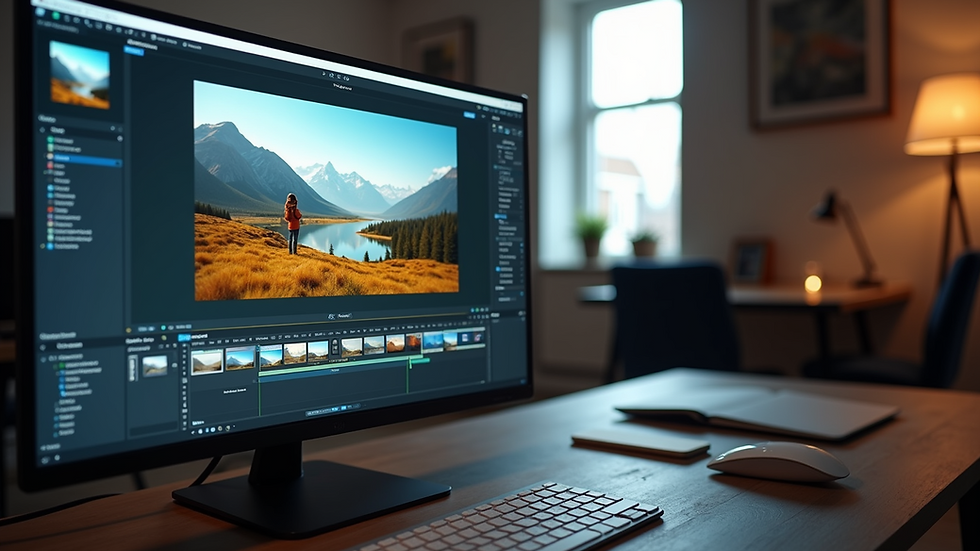Mastering the Art of Photo Editing
- Tetiana Rudenko
- Aug 14
- 3 min read
Photo editing is more than just a technical skill - it is a form of expression that can transform ordinary images into stunning works of art. Whether you are a beginner or looking to refine your craft, mastering creative editing skills can elevate your photography and help you tell compelling visual stories. This guide will walk you through essential techniques, tools, and tips to enhance your photos with confidence and style.
Developing Your Creative Editing Skills
Creative editing skills are the foundation of producing captivating images. These skills involve understanding how to manipulate light, color, composition, and texture to bring out the best in your photos. Here are some practical ways to develop these skills:
Learn the basics of exposure and color correction. Adjust brightness, contrast, highlights, and shadows to balance your image naturally.
Experiment with cropping and framing. Sometimes, changing the composition can dramatically improve the photo’s impact.
Use layers and masks. These allow you to apply edits selectively without affecting the entire image.
Play with filters and effects. Subtle use of filters can add mood or style, but avoid overdoing it to keep your photos authentic.
Practice regularly. The more you edit, the better you understand how different adjustments affect your images.
For example, if you have a landscape photo that looks dull, try increasing the vibrance and clarity to make the colors pop and details sharper. Then, crop the image to remove distracting elements and focus on the main subject.

Essential Tools for Enhancing Your Creative Editing Skills
Choosing the right tools can make a significant difference in your editing workflow. Here are some popular and user-friendly options:
Adobe Lightroom - Ideal for beginners and professionals alike, Lightroom offers powerful tools for color correction, exposure adjustments, and batch editing.
Adobe Photoshop - Best for advanced editing, Photoshop allows detailed retouching, compositing, and creative effects.
Capture One - Known for excellent color grading and tethered shooting capabilities.
Mobile Apps - Snapseed, VSCO, and Lightroom Mobile provide great editing features on the go.
When selecting software, consider your editing goals and the complexity of your projects. For instance, Lightroom is perfect for quick edits and organizing photos, while Photoshop is better suited for intricate manipulations.
What is the app that changes photos to art?
Transforming photos into artistic creations has become increasingly popular, and several apps specialize in this. These apps use artificial intelligence and filters to convert your images into paintings, sketches, or other art styles.
Prisma - One of the most well-known apps, Prisma applies various artistic filters inspired by famous painters like Van Gogh and Picasso.
DeepArt - Uses AI to recreate your photos in the style of classic artworks.
Painnt - Offers a wide range of artistic filters with customization options.
These apps are user-friendly and perfect for those who want to experiment with artistic effects without deep technical knowledge. Simply upload your photo, choose a style, and let the app do the rest.

Tips for Achieving Professional-Looking Edits
To make your edits look polished and professional, keep these tips in mind:
Maintain natural skin tones when editing portraits to avoid unrealistic colors.
Use the histogram to check exposure and avoid clipping highlights or shadows.
Sharpen selectively to enhance details without introducing noise.
Save your edits in layers so you can revisit and adjust them later.
Calibrate your monitor to ensure colors are accurate.
For example, when editing a portrait, start by adjusting the exposure and white balance. Then, use a soft brush to smooth skin imperfections subtly. Finally, enhance the eyes and lips to draw attention without over-editing.

Exploring artistic photo editing Techniques
Artistic photo editing goes beyond basic corrections and involves creative manipulation to produce unique visual effects. This can include:
Double exposure - Combining two images to create surreal compositions.
Selective color - Highlighting one color while converting the rest to black and white.
Texture overlays - Adding grain, scratches, or light leaks for a vintage or cinematic look.
Digital painting - Using brushes and effects to turn photos into paintings.
These techniques require practice and experimentation but can significantly enhance your portfolio. For instance, try blending a portrait with a textured background to add depth and emotion.
Elevate Your Photos with Consistent Practice
Mastering photo editing is a journey that requires patience and dedication. Set aside time regularly to practice different techniques and explore new tools. Join online communities, watch tutorials, and seek feedback to improve continuously.
Remember, every photo is an opportunity to tell a story. With the right creative editing skills, you can transform your images into powerful visual narratives that captivate and inspire.
Keep experimenting, stay curious, and enjoy the process of mastering the art of photo editing.



Comentarios